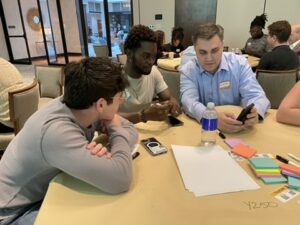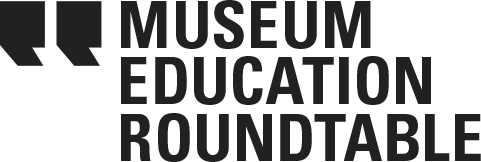Gen Z Perspective: How Museums Can Cultivate Civic Wellness
What is civic wellness? The Journal of Museum Education’s spring 2025 issue draws on the term, used as an umbrella term to describe explicitly social justice and community-oriented programming in museums, to explore partnerships between museums and civic organizations. This blog post invites the reader into a case study of civic wellness in action through Gen Z engagement in Made By Us.
Alex Edgar is the Youth Engagement Manager at Made By Us, an organization that connects history to younger generations in innovative and meaningful ways through its coalition of over 400 museums and cultural institutions nationwide. Paola Alonso Guerrero and Wyatt Nako are two members of their newest initiative, the Youth250 Bureau, a group of 100 young adults, ages 18-30, being trained to advise institutions across the country on increasing their youth engagement in the lead up to the the 250th anniversary of the United States’ Declaration of Independence in 2026.
For this blog, Alex interviewed Paola and Wyatt who shared their thoughts on the importance of museums to Gen Z, strategies for connecting with young adults, and how museums can cultivate civic wellness.

Alex Edgar: What drew you into the Made By Us universe? What about museums and cultural institutions made you want to be a part of this world?
Paola Alonso Guerrero: I became interested in working in museums and history when I was in college. I originally went in for nursing but found I was terrible at it. I had a wonderful history professor who talked about American history in a way that was so authentic, something I hadn’t experienced during my K-12 education. As a first-generation immigrant who grew up in a Spanish-speaking household, I didn’t grow up going to museums, but I knew their impact. Museums are often the site of school trips, some of kids’ most memorable experiences. I wanted to bridge the gap between museums and accessibility and help platform under-told stories.
Wyatt Nako: Mine is similar, but from a different angle. I’m looking to go to law school, but I’ve been invested in education and the arts. Museums sit at that intersection. I’ve been thinking about how museums and educational institutions empower young people. Seeing yourself in museums, seeing people who look like you, come from where you’re from, and even think differently than you, expands your perspective and makes you feel like you can bring something new to the world. Museums are a powerful space for that.
Alex: Was there a singular museum experience that shaped your perspective, especially in terms of civic wellness and community development?
Wyatt: Yes, visiting Iolani Palace in Hawaii in eighth grade. We were learning about Queen Liliuokalani and how she was imprisoned in her own palace, in her own bedroom. What struck me was that even while imprisoned, she wrote music to communicate with her people. Somehow, through maids or other means, her music spread. It made me realize how empowered she must have felt to do that sneakily, in a counter-authority way, through art. It underscored the power of arts and music.
Paola: That’s beautiful. Museums connect us to history, showing how much agency and power people have had, even in the most difficult circumstances. I don’t have one singular museum experience because I haven’t been to many, but every museum visit has been impactful. Thinking about the intent behind every exhibit, every label, every artifact, it’s all about connecting the stories of people from our past. Museums help us connect to humanity, and themes of power, resistance, and strength are common threads.
Alex: What could museums be doing to better foster that sense of shared humanity and connection to their communities?
Paola: Museums should find what is needed in their communities. At the museum I work at, we hosted an exhibit about 1930s fashion and how people repurposed feed sacks into clothing during the Depression. To connect with our community, we organized a clothing drive where people could donate clothes, and we provided free clothing to those in need. Sometimes, museums can serve as a space where people can have a basic need met, whether that’s education, air conditioning, clothing, or food.
Wyatt: Museums are among the most trusted institutions in any given town, city, or country. Leveraging that trust to serve communities is powerful. When museums step in to help, there’s no political or business agenda: it’s simply for the public good. That’s why people trust them.
One thing I love is when museums incorporate interactive art activities. Having something as simple as a coloring sheet where visitors can color a famous picture of their town creates a way for guests to participate in history. It also provides a resting and reflection spot—after walking through a museum, people can sit, talk, and engage in history in a relaxed way.
Alex: What challenges do young people in your communities face that museums could address?
Paola: Awareness. Many young people don’t even know what’s available in their local museums. I’m from Dallas, where we have many museums, but smaller institutions often go unnoticed compared to larger ones. We’re not in competition, but people don’t always realize the breadth of opportunities museums offer. There’s also a knowledge gap, as many young people don’t realize the variety of careers within museums, from archivists to curators to educators. Not seeing yourself represented in museums leads to disengagement.
Wyatt: Our generation needs to go outside and touch grass. Museums could provide more outdoor spaces or areas that feel less screen-heavy. Iolani Palace, for example, has no screens. It’s just historical artifacts, preserved, with signs and guides. No distractions, no phones, no flash photography; it’s a fully immersive experience. Museums should think about how to create those tech-free, reflective spaces.
Alex: Should museums lean into technology or create more tech-free spaces to better engage young audiences?
Wyatt: Either approach can work, but whichever direction a museum chooses, it has to be done well. A Super Bowl performance exhibit, for example, would need video footage to be engaging, while a historical exhibit might benefit from less tech. The key is ensuring technology serves the experience rather than being included just for the sake of it.
Paola: It also depends on the generation. Older Gen Z is over excessive tech; we don’t want to scan QR codes for menus anymore. But younger Gen Z is much more comfortable with technology. Tech implementation in museums needs to be intentional and relevant to the exhibit.
Alex: Civic wellness is about community connection and care. How can museums stay in touch with their communities’ needs and create exhibits or programs that drive engagement?
Wyatt: Futurism. The Smithsonian’s National Museum of African American History and Culture’s Afrofuturism exhibit was incredibly popular. Museums should create exhibits that explore the future of their communities, integrating the perspectives and aspirations of local people. It naturally fosters engagement because it’s a history that hasn’t yet been written—it’s being built with the community.
Paola: History isn’t always pleasant, and Gen Z can feel helpless when faced with tragic past events. Museums should bridge the gap between difficult history and civic action. Present the history of what happened, show how people resisted and endured, and then empower the current generation to take action. Not only do you learn from the past, but you also take steps to shape a better future.

Looking for more insights from incredible young people like Paola and Wyatt? Work with the Youth250 Bureau from Made By Us for free as we approach the U.S. 250th.
Are you part of a US history organization? Join the Made By Us coalition and become part of the movement to bring credible history to young people.
Learn more and connect with Made By Us on Instagram and TikTok @historymadebyus.
Author Biographies:
Alex Edgar is a Gen Z civic leader reshaping how institutions engage younger, diverse audiences. As Youth Engagement Manager at Made By Us, he leads the Youth250 Bureau, ensuring Gen Z voices shape the U.S. 250th anniversary. He serves on several boards, including Points of Light and the U.S. Census Bureau’s 2030 Census Advisory Committee, where he is the youngest appointee in Department of Commerce history. An Eagle Scout and UC Berkeley graduate, Alex is dedicated to mentoring young changemakers.
Paola Alonso Guerrero is an archivist and history professional at the Irving Archives and Museum, who is passionate about amplifying underrepresented narratives and is devoted to making history accessible and engaging for diverse audiences. She strives to foster a deeper connection to the past by exercising her lived experience as a Gen-Z Mexican American woman and her expertise in writing and historical preservation.
Originally from Honolulu, Hawaiʻi, Wyatt Nako is currently a junior at Georgetown University studying Philosophy and Government. He is passionate about improving civil discourse and supporting the telling of local and marginalized histories, as well as using expression and the arts in our education systems as pathways toward youth empowerment.

